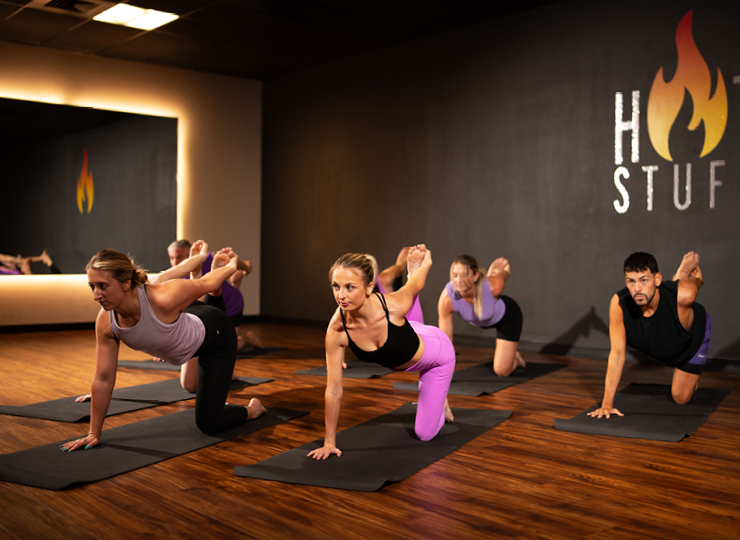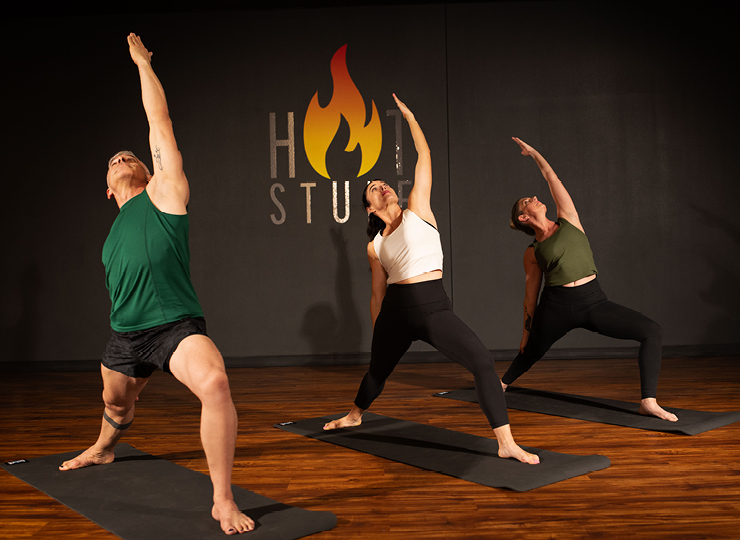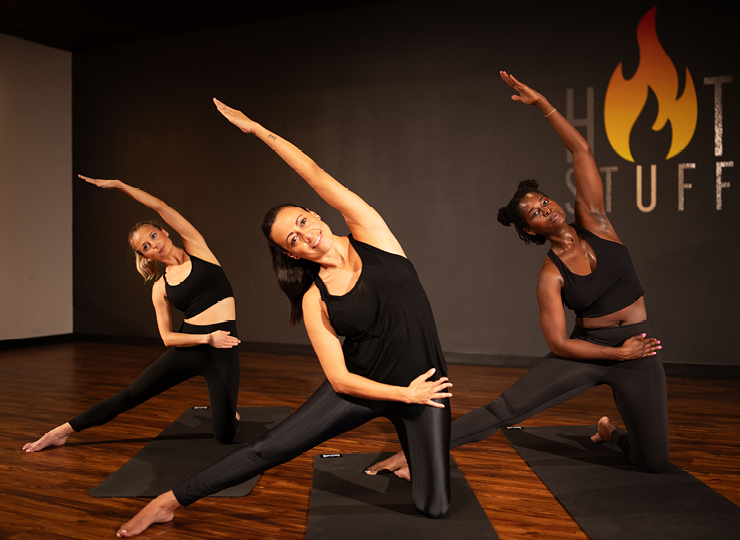
If you’ve ever considered trying hot yoga, you might wonder, “Why does it feel so intense?” Typically, hot yoga is practiced in studios heated to temperatures ranging from 95°F to 105°F (35°C to 40.5°C).
This elevated heat is designed to make you sweat, increase flexibility, and provide a more intense workout experience.
But understanding what temperature is hot yoga is just the start – knowing how these temperatures affect your body and what benefits you can gain from practicing in such a heated environment is essential.
In this article, we’ll answer the question, “What temperature is hot yoga?” by exploring the standard heat levels used in most classes and the reasons behind these specific temperatures.
We’ll also discuss how the heat impacts your body, the benefits you can expect, and some essential safety tips to help you stay comfortable and safe during your practice.
Whether you’re an advanced or a beginner yogi looking to try hot yoga, knowing what to expect regarding temperature can help you make the most of your experience.

What Is A Hot Yoga Class?
Hot yoga takes traditional yoga to the next level by adding a heated, humid environment for an intense workout.
This yoga class uses special equipment, like radiant heating panels or space heaters, to create the perfect temperature that encourages plenty of sweating. The goal? To boost your flexibility and endurance while working up a serious sweat in a hot room!
The original hot yoga style, Bikram Yoga, was developed by Bikram Choudhury in the 1970s and featured a strict routine of 26 poses and two breathing exercises in a hot room heated to 105°F with 40% humidity.
However, hot yoga classes today are much more flexible. Unlike Bikram, they don’t stick to specific temperatures or humidity levels, and each class can feature a different mix of poses, depending on the vibe of the yoga instructor.
Hot yoga is all about using heat and movement to help your body detox through sweat and push your limits with every session!
Hot Yoga Styles
Bikram Yoga is just one of the many exciting hot yoga styles you can explore. Each practice offers a unique approach, allowing you to find the perfect fit for your fitness goals and preferences. Here are some popular variations to consider:
Hot Yoga: Fierce: An empowering practice that blends dynamic movements with a heated environment to challenge your strength, endurance, and flexibility.
Hot Yoga: Flow: A fluid, heat-enhanced Vinyasa-style yoga class that connects breath with movement, designed to build strength and enhance balance while working up a serious sweat.
Hot Yoga: Foundation: Perfect for beginners or anyone looking to refine their practice, this class focuses on fundamental poses in a heated setting to build a solid base in hot yoga.
OmHIIT Yoga: Combines yoga mindfulness with the intensity of high-intensity interval training (HIIT) in a hot room to deliver a full-body workout that pushes your limits.
Iron Mat: A hot yoga class incorporating bodyweight exercises and yoga poses to build strength, endurance, and flexibility on the mat.
Unbreakable Yoga: A challenging hot yoga class designed to test your mental and physical resilience with intense sequences and powerful postures.
Are you already convinced that Crunch is the place for you? Click here to sign up for your next yoga class and start sweating it out today!
Types of Hot Yoga Classes: Optimal Temperature and Humidity
Bikram Yoga
The most recognized style of hot yoga, Bikram classes run for 90 minutes and follow a strict sequence of 26 poses. Studios typically heat the room to 105°F with a humidity level of around 40%, though some may raise it to 60%. This combination creates a “feels like” temperature between 121°F and 149°F, providing an intense and challenging environment for practitioners.
CorePower Yoga
CorePower offers a variety of classes, all designed around a flowing yoga practice. The room temperature is usually maintained between 93°F and 98°F, providing a warm but more moderate environment than Bikram Yoga.
Power Vinyasa
These classes, which last 75 to 90 minutes, focus on flowing postures designed to build strength, flexibility, and endurance. Studios generally heat the room between 90°F and 95°F and often add humidity or fresh air to enhance the experience.
This style is accessible to all levels and offers various modifications. Many studios also offer 60-minute classes that emphasize movement and flow.
Temperature vs. Humidity in Hot Yoga: A Detailed Overview
In hot yoga, temperature and humidity are key to creating the ideal environment for practice, each offering distinct benefits.
Temperature
As mentioned before, hot yoga studios typically maintain temperatures between 90-105°F (32-40°C). This elevated heat increases core body temperature, promoting deeper stretches by loosening muscles and tendons.
Studies show warmer muscles are more flexible, reducing the risk of injury and allowing for an enhanced range of motion. The high temperature also triggers the body to sweat more, eliminating toxins and enhancing detoxification.
Additionally, the high heat increases the heart rate, turning yoga into a more cardiovascular-focused workout, which can improve cardiovascular health and stamina over time.
However, the high temperatures also require participants to listen to their bodies and modify poses to avoid overheating.

Humidity
As we know, humidity levels in hot yoga generally fall between 40% and 60%. This factor is crucial because it affects how the body perceives temperature.
A higher humidity level amplifies the sensation of heat, making the environment feel hotter than it is. This can increase the intensity of the workout, further stimulating perspiration and promoting detoxification.
Humidity also helps maintain moisture in the air, preventing the body from drying out too quickly during practice.
However, excessive humidity can lead to discomfort or dehydration if not properly managed. That’s why finding the right humidity balance is important for safety and comfort.
Balancing for Optimal Practice
Hot yoga is challenging and invigorating when temperature and humidity are properly balanced. However, too much heat or humidity can increase the risk of heat exhaustion or dehydration.
Participants should stay hydrated before, during, and after class. Maintaining body awareness, adjusting poses, and taking breaks when necessary are crucial for practicing safely.
It’s essential for participants to stay hydrated before, during, and after class. Maintaining body awareness, adjusting poses, and taking breaks when necessary are crucial for practicing safely.
Temperature and humidity in hot yoga create an environment that challenges the body, deepens stretches, and promotes overall well-being while encouraging focus and mindfulness.
Physiological Effects of Heat in Hot Yoga Class
The intense heat in hot yoga can have mixed physiological effects on the body, which can be beneficial and potentially risky, depending on the individual’s health and how they approach their practice.
Understanding these effects—such as increased heart rate, sweating, and the impact on mental health and flexibility—can help practitioners decide whether hot yoga is right for them.
Heart Rate and Cardiovascular Benefits
When practicing yoga in a heated environment, the body’s core temperature rises, increasing heart rate. Research shows that hot yoga sessions can elevate the heart rate to levels associated with moderate to vigorous cardiovascular workouts, similar to quick walking or light jogging.
This makes hot yoga an effective way to engage the cardiovascular system and improve cardiovascular fitness. However, for those with pre-existing conditions, it’s important to avoid hot yoga or consult a healthcare provider, as the elevated heart rate could strain the heart and raise blood pressure to dangerous levels.
Sweating and Detoxification
Sweating is one of the body’s primary mechanisms for cooling itself during hot yoga, and it is a common effect of the elevated core temperature.
This profuse sweating helps eliminate toxins, cleanse the skin, and regulate body temperature. However, it is crucial to stay properly hydrated to compensate for the significant fluid loss.
Dehydration can lead to dizziness, nausea, or more severe conditions like heat exhaustion or heat stroke, especially in a hot yoga environment.
Mental Health Benefits: Easing Depression
The heat in hot yoga is also believed to affect mental health positively. Studies have suggested that practicing yoga in a heated environment can help ease symptoms of depression and anxiety.
The combination of physical exertion, focused breathing, and increased body temperature may trigger the release of endorphins, which can improve mood and reduce stress.
Additionally, yoga’s mindful aspect and the challenge of managing discomfort in a heated room can enhance mental resilience and promote a sense of accomplishment.
Improved Flexibility
Hot yoga is often associated with increased flexibility due to the heated environment. The warmth allows muscles to relax and stretch more effectively, making achieving deeper poses and movements easier.
Research indicates that practicing in a heated room can increase the range of motion and improve joint flexibility, potentially reducing the risk of injury.
However, it is important to listen to your body and avoid overstretching, as the heat can sometimes mask pain and discomfort, leading to strains or injuries.

Risks and Safety Considerations
Hot yoga is generally considered safe for most people, but there are important safety factors to keep in mind when practicing it. Due to the heated environment, muscles may become overly loose, potentially leading to overstretching and injury, particularly in tendons and ligaments.
Hot yoga can also increase the risk of heat-related illnesses.
Individuals with certain health conditions, such as cardiovascular diseases (including heart disease or a history of stroke), heat intolerance, or a history of heat stroke, should consult with their doctor before engaging in hot yoga.
Certain conditions may also increase the likelihood of fainting in a hot environment. Those with diabetes, arterial abnormalities, anorexia nervosa, a history of fainting, low blood pressure, or low blood sugar should exercise caution when trying hot yoga.
Pregnant women should always consult with their healthcare providers before attempting hot yoga. A study indicates that exposure to excessive heat during pregnancy could increase the risk of neural tube defects and other fetal malformations. As a result, it is crucial for pregnant people to carefully weigh the risks and consult with their healthcare professionals before starting hot yoga.
Ready to Elevate Your Hot Yoga Practice?
At Crunch Fitness, we offer a range of hot yoga styles to suit every fitness level! Whether you’re building strength with Hot Yoga: Fierce, finding your flow in Hot Yoga: Flow, or refining your fundamentals in Hot Yoga: Foundation, we’ve got a class for you. For an extra challenge, try OmHIIT Yoga for a HIIT-infused yoga experience, Iron Mat to build serious endurance, or Unbreakable Yoga to push your limits.
Join us!
Crunch’s group fitness classes promote a culture of fun with no judgments. It’s an environment for all types of individuals with various goals. Find a Crunch gym near you to try our free trial membership, or join Crunch now. Your goals are made to be crushed. With Crunch, you’ll have the tools, resources, and support to make it happen.



































































































































































































